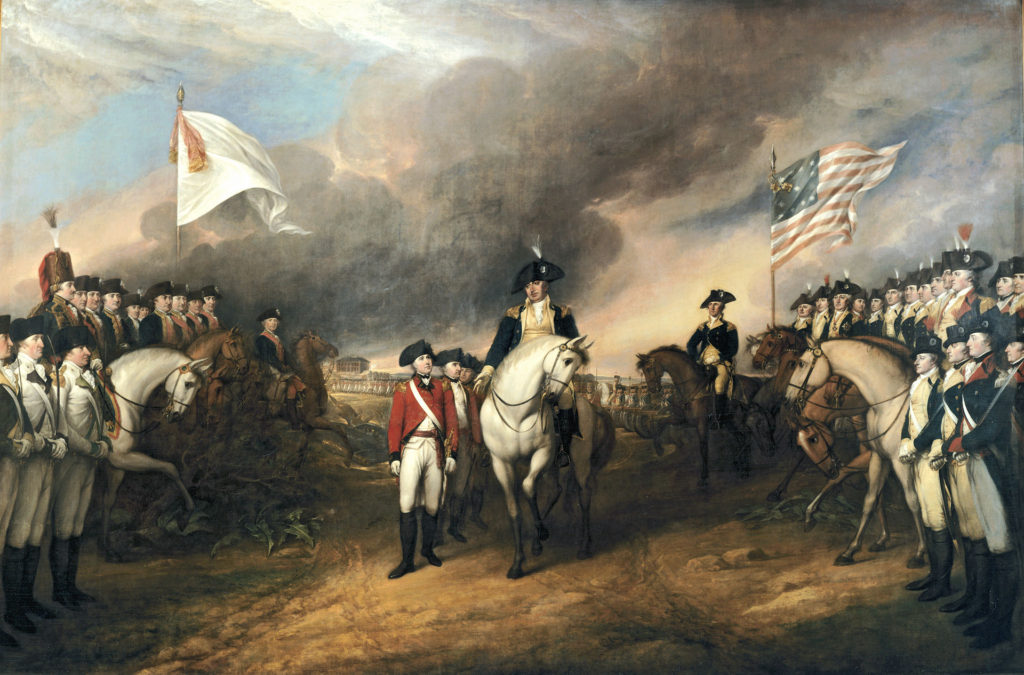Good morning, Whitewater.
Midweek in town will be partly cloudy with a high of sixty-nine. Sunrise is 7:14 AM and sunset 6:04 PM, for 10h 49m 53s of daytime. The moon is a waning gibbous with 84.4% of its visible disk illuminated.
The Community Development Authority meets at 5:30 PM this afternoon, and the Parks & Recreation Board at 6:30 PM.

This painting depicts the forces of British Major General Charles Cornwallis, 1st Marquess Cornwallis (1738-1805) (who was not himself present at the surrender), surrendering to French and American forces after the Siege of Yorktown (September 28 – October 19, 1781) during the American Revolutionary War. The United States government commissioned Trumbull to paint patriotic paintings, including this piece, for them in 1817, paying for the piece in 1820.
On this day in 1781, America & France are victorious at the Battle of Yorktown, effectively ending the Revolutionary War:
The Siege of Yorktown, also known as the Battle of Yorktown, the Surrender at Yorktown, German Battle or the Siege of Little York,[a][b] ending on October 19, 1781, at Yorktown, Virginia, was a decisive victory by a combined force of American Continental Army troops led by General George Washington and French Army troops led by the Comte de Rochambeau over a British Army commanded by British lord and Lieutenant General Charles Cornwallis. The culmination of the Yorktown campaign, the siege proved to be the last major land battle of the American Revolutionary War in the North American theater, as the surrender by Cornwallis, and the capture of both him and his army, prompted the British government to negotiate an end to the conflict. The battle boosted faltering American morale and revived French enthusiasm for the war, as well as undermining popular support for the conflict in Great Britain.[8]
In 1780, approximately 5,500 French soldiers landed in Rhode Island to assist their American allies in operations against British-controlled New York City. Following the arrival of dispatches from France that included the possibility of support from the French West Indies fleet of the Comte de Grasse, Washington and Rochambeau decided to ask de Grasse for assistance either in besieging New York, or in military operations against a British army operating in Virginia. On the advice of Rochambeau, de Grasse informed them of his intent to sail to the Chesapeake Bay, where Cornwallis had taken command of the army. Cornwallis, at first given confusing orders by his superior officer, Henry Clinton, was eventually ordered to build a defensible deep-water port, which he began to do in Yorktown, Virginia. Cornwallis’ movements in Virginia were shadowed by a Continental Army force led by the Marquis de Lafayette.
The French and American armies united north of New York City during the summer of 1781. When word of de Grasse’s decision arrived, the combined armies began moving south toward Virginia, engaging in tactics of deception to lead the British to believe a siege of New York was planned. De Grasse sailed from the West Indies and arrived at the Chesapeake Bay at the end of August, bringing additional troops and providing a naval blockade of Yorktown. He was transporting 500,000 silver pesos collected from the citizens of Havana, Cuba, to fund supplies for the siege and payroll for the Continental Army.[9] While in Santo Domingo, de Grasse met with Francisco Saavedra de Sangronis, an agent of Carlos III of Spain. De Grasse had planned to leave several of his warships in Santo Domingo. Saavedra promised the assistance of the Spanish navy to protect the French merchant fleet, enabling de Grasse to sail north with all of his warships.[10] In the beginning of September, he defeated a British fleet led by Sir Thomas Graves that came to relieve Cornwallis at the Battle of the Chesapeake. As a result of this victory, de Grasse blocked any escape by sea for Cornwallis. By late September Washington and Rochambeau arrived, and the army and naval forces completely surrounded Cornwallis.
After initial preparations, the Americans and French built their first parallel and began the bombardment. With the British defense weakened, on October 14, 1781 Washington sent two columns to attack the last major remaining British outer defenses. A French column took redoubt #9 and an American column took redoubt #10. With these defenses taken, the allies were able to finish their second parallel. With the American artillery closer and more intense than ever, the British situation began to deteriorate rapidly and Cornwallis asked for capitulation terms on the 17th. After two days of negotiation, the surrender ceremony took place on the 19th; Lord Cornwallis, claiming to be ill, was absent from the ceremony. With the capture of more than 7,000 British soldiers, negotiations between the United States and Great Britain began, resulting in the Treaty of Paris in 1783.
JigZone‘s puzzle for Wednesday is of a butterfly on a blue flower:
